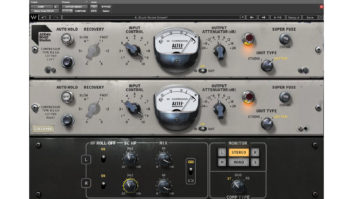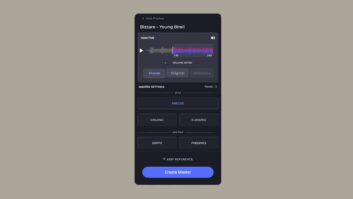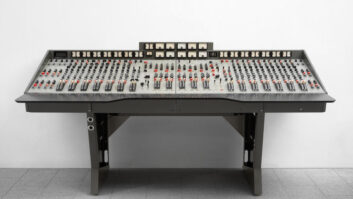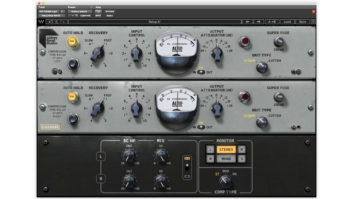Over the years, Waves has developed quite a few plug-ins in conjunction with Abbey Road Studios, all of them modeling actual gear from the famed facility. The latest, Abbey Road TG Mastering Chain, is an emulation of the TG12410 Transfer Console that’s been a mainstay in Abbey Road’s mastering studios since the 1990s.
Like the console itself, the plug-in is made up of four modules and an output stage. You can turn each module on and off as needed, so if you’re on a slow computer or have a huge session, you’ll appreciate being able to save CPU that way.
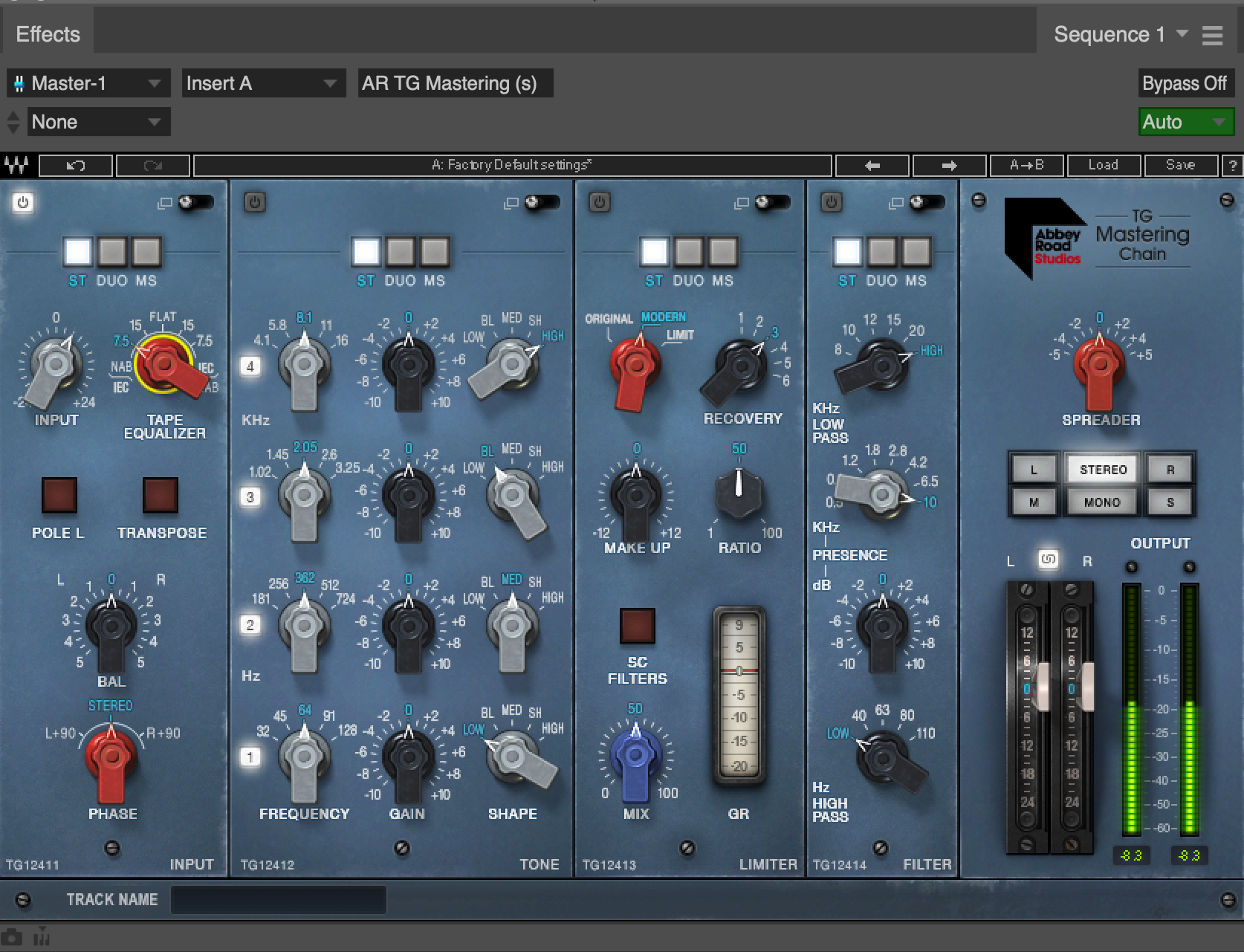
Each module can be independently switched between stereo (ST), dual mono (Duo) and mid-side (MS) operation, providing a slew of processing options. For example, you could compress only the mid-channel elements while EQing just the side elements and applying a lowpass filter to the stereo mix. Lots of room for experimentation.
By clicking on the Expand/Collapse button, in the upper right corner of each module, an expanded view opens that contains additional controls. You can further switch between the expanded view of one module to that of another using one of four Expanded Module Navigation buttons at the top.
When you purchase the plug-in, not only do you get mono and stereo instances, but also a “live version” (both mono and stereo) for which Waves swapped out the linear phase filters and performed some other latency-saving revisions. Basically, you’re trading a little bit of quality for less latency. It’s pretty hard to tell the difference with the naked ear. For large mix sessions, the live versions could come in handy.
Also included is the Abbey Road TG Meter Bridge, which is a separate plug-in that you can use for adding some metering features beyond what’s on the console plug-in itself. There are peak, VU and phase-correlation meters included on the Meter Bridge. For the peak and VU meters, you can choose to see Input, Output or Gain Reduction, which is handy because the Gain Reduction meter on the console plug-in is small, making it hard to judge levels precisely.
If you have multiple instances of TG Mastering Chain open in a mix, all you need is one instance of the TG Meter Bridge. It has a Track Name pulldown menu, which allows you to select which one to connect the meters to.
Module by Module
By default, the modules in TG Mastering Chain are set up in the following order: Input, Tone (EQ), Limiter and Filter, followed by the Output section. The Tone, Limiter and Filter modules can be rearranged in any order.
The Input module offers quite a bit of functionality. On a stereo instance, in addition to an Input level control and L/R Balance control, you get a Transpose button to flip left and right and two different phase controls. One, called the Pole switch, flips the input phase by 180 degrees and can be separately applied to the left and right channels in a stereo instance of the plug-in. One slight inconvenience is that only the left Pole button shows in the default collapsed GUI view. You have to expand the module to access both left and right buttons.
The Phase knob lets you flip one channel out of phase with the other by 90 degrees. It can either be Off, L+90 or R+90. Waves recommends using this feature on stereo tracks with phase-correlation issues.
Perhaps the most useful part of the Input module is the Tape Equalizer. This was part of the hardware console for applying an EQ curve designed for playing a recording made on an NAB-standard machine on an IEC machine, or the other way around. You won’t need it for its original purpose, but you can use it for some cool EQ flavoring. You get 15 and 7.5 ips settings for NAB and IEC, and I found that they often added pleasant character to a source or mix.
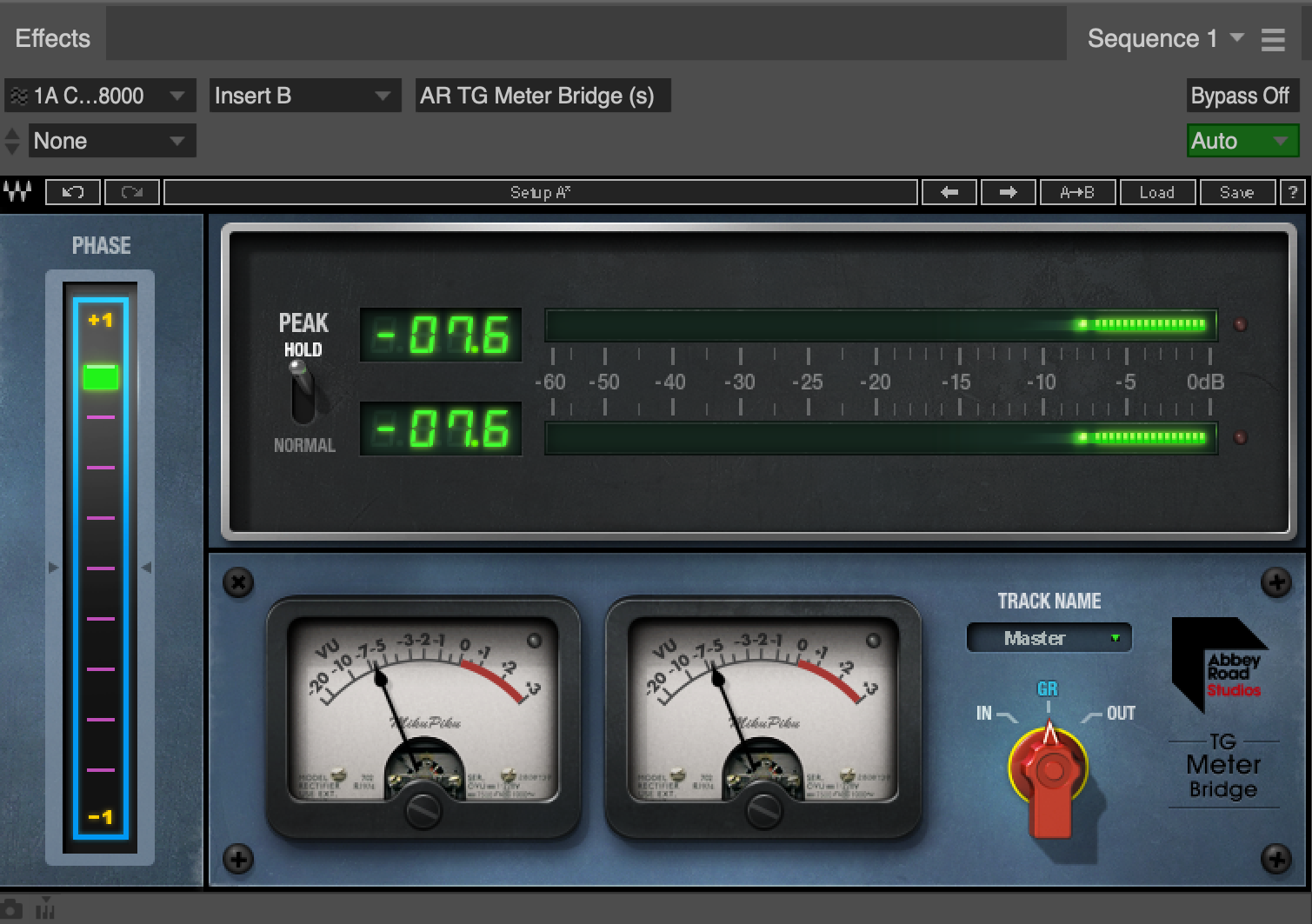
All Things Being Equalized
If you want more direct control over the frequency content, the Tone module provides a 4-band equalizer. Band 1 covers low frequencies; Band 2, lower-midrange; Band 3, upper-midrange; and Band 4, high frequencies. Each offers five preset frequencies appropriate for its range.
You can cut or boost gain –10 dB to +10 dB in .05 dB increments per band. You can also choose a filter type for each band from five choices: Low (low shelf), BL (short for “Blunt,” a very wide bell), MED (moderately wide bell), SH (for “Sharp,” a narrow bell) and High (high shelf). When you’re in Expanded view, you also get a Band Monitoring switch per band, allowing you to solo it while adjusting.
The EQ sounds clean, and the frequencies are well-chosen. You don’t get the precision you’d get with freely adjustable frequencies and Q widths, but there’s something to be said for working within the limitations of a modeled hardware unit, especially one that’s based on a unit from a facility with a track record like Abbey Road Studios.
Squeezing Signals
The Limiter module lets you choose one of three algorithms: Original is based on the Zener Diode compressor in the actual hardware unit. Modern is a VCA compressor algorithm that Waves and Abbey Road developed specifically for the plug-in. The third, Limit, models the limiter in the Zener Diode compressor, but with a significantly harder knee. Modern was my favorite of the three by a considerable margin.
None of the compressor or limiter algorithms are of the brickwall variety, nor are there dither features, so this plug-in would probably not be used last in a mastering chain. You would likely want to add a mastering limiter with dither after it. This isn’t a knock on the TG Mastering Chain, just a clarification that, despite its name, it doesn’t have those processes included.
The Limiter module also features a Ratio knob, which doesn’t give you standard ratios, but rather a scale of 1 to 100. It takes a little getting used to, but it actually provides a surprising amount of control. The threshold is fixed, so you have to use either a higher ratio setting or more input gain if you want more compression.
The Recovery switch gives you six preset combinations of attack and release times, ranging from slow to fast. The default setting is the third position. No real specs are provided, so you have to experiment. In addition to a Make Up Gain knob, you also get a Mix control, which lets you back off on the compression without adjusting the ratio, while allowing for parallel compression.
The Limiter has a Sidechain Filter feature, which was not on the hardware console but proves useful, particularly for reducing bass-heavy signals going into the detector. You get three separate filters: High-Pass, Low-Pass and Bell. The latter has a 100 Hz to 12 kHz continuous frequency control and a Gain knob.
The Filter module, like the EQ module, offers preset frequency selection knobs. The High Pass offers 40, 65, 80 and 110 Hz, and the Low-Pass 8, 10,12, 15 and 20 kHz.
The Low-Pass has an additional step on its frequency knob called High, and the High-Pass has one called Low. Both function as “Off” switches for their respective filters. I assume this is how it’s set up on the original console, but it sure confused me until I looked it up in the manual. I would have preferred they call it “Off” or “Bypassed.”
You also get a third filter, Presence, which includes eight different fixed-cutoff frequencies from 0.5 kHz up to 10 kHz, and a ±10 dB gain knob. The Presence band gives you an extra place to add some sparkle in addition to the EQ.
Out With It
The Output section includes output gain controls (which can be linked or unlinked) and ladder-style meters. It also lets you monitor in Stereo, Mono, or just the Left or Right, or Mid or Side, which is handy.
It also has, the Spreader knob— one of the cooler features on the plug-in—which adjusts the width of the stereo field using MS processing.
Overall, I was quite impressed with the TG Mastering Chain. It gives you a nice blend of features, flexible signal order, multiple operation modes (ST, Duo, MS), excellent metering, particularly when used in conjunction with the TG Meter Bridge, and a vibey, vintage sound.
Despite its name, this plug-in is not just for mastering—it’s great for mixing, too. I used it on individual tracks like kicks, snares, overheads, electric bass, acoustic guitar and vocals, and it was always useful for sculpting and improving the sound. It makes for a powerful channel strip.
I also had excellent results with it on drum buses, overheads and on the master bus. The tape EQ in the Input module adds a range of flavor, and the limiter (particularly the Modern algorithm) not only sounds good, but offers flexible dynamics control. Having the Spreader right at my fingertips was great when working on stereo content, particularly full mixes.
Although the retail price for the plug-in is $199, Waves is running a discount at the time of this writing of $49. Either way, you’re getting a great deal and some excellent processing options.
PRODUCT SUMMARY
Company: Waves
Product: Abbey Road TG Mastering Chain
Website: waves.com
Price: $199
Pros: Stereo, dual mono or MS control for each module; Tape EQ adds cool vibe; EQ section offers multiple and varied filter shapes; Solo switches for monitoring EQ bands; Limiter module includes sidechain filters; Modern limiter setting sounds particularly good; Spreader knob makes stereo-width adjustment easy; modules can be individually turned off, and most can be re-ordered
Cons: Bypass setting for highpass and lowpass filters is confusing; only the left Pole switch shows in Input module’s default view; gain reduction meter on Limiter module is hard to read precisely

